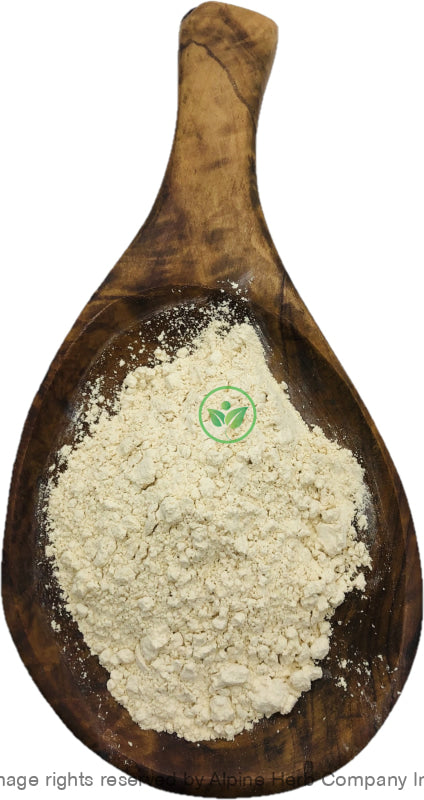Horseradish Root Powder Alpine Herb Company Inc.
$ 12,49 $ 7,49
Botanical Name: Cochlearia armoracia
Common Name:
- English: Horseradish Root
- Also, known as: Amoraciae Rusticanae Radix, Armoracia lopathifolia, Armoracia rusticana, Cochlearia armoracia, Cran de Bretagne, Cranson, Grand Raifort, Great Raifort, Meerrettich, Mountain Radish, Moutarde des Allemands, Moutarde des Capucins, Moutardelle, Nasturtium armoracia, Pepperrot, Rábano Picante, Rábano Rústico, Radis de Cheval, Raifort, Raifort Sauvage, Red Cole, Rorippa armoracia
Origin: China
Harvested: Cultivated
Parts Used: Root
General Information:
Cochlearia armoracia is a large-leaved, hardy European perennial herb that has been a culinary favorite for more than 3,000 years, grows up to 5 feet tall, and is cultivated primarily for its large, white, tapered root. Horseradish is a member of the mustard family, along with kale and turnips, so its bite makes a lot of sense. The perennial root sends up numerous smooth, erect, branch stems, growing 2–3 feet high. The large leaves are lanceolate, waved, scalloped on the edges and stand up on 1foot long stalks. The flowers are numerous and white, followed by seed pods divided into two cells, each containing four to six seeds. The hot, biting root is tapering, conical at the top; fleshy, whitish externally.
The intact horseradish root has hardly any aroma. Once exposed to air or heat it will begin to lose its pungency, darken in color, and become an unpleasantly bitter tasting over time. The fresh root is much more powerful than the dried. Both roots and leaves were used as a medicine during the Middle Ages and the root was used as a condiment for meats in Germany, Scandinavia, and Britain. It was introduced to North America during European colonization. Plants can be grown from seed, but it is far easier to raise from pieces of root, known as thongs, which are available from specialist growers in spring or from pot-grown plants that can be bought all year round.
How to use:
Powdered Herb:
There are different ways to use powdered herb.
Food Preparation: You can add powdered herbs to any super food, herbal smoothie, sauces, spreads and even cookies. Also for children, you can mix powdered herbs with honey or glycerin to make a paste. The thicker the paste, the more potent and herbal in taste. The sweet taste of honey and glycerin will help the medicine go down. This method is also known as “Electuaries”.
Capsules: Encapsulating your own powdered herb at home, give you assurance that the contents of the capsules are pure herb and no filler or any other products. These capsules can be taken with liquid.
Poultice: Poultice can be made with an herbal powder and liquid (mostly water) to form a paste which is then applied to the skin. This method is very helpful for skin conditions.
Herbal shot: Powdered herb can be mixed with water, fruit juice or other liquid to make herbal shot.
Precautions:
You should consult with a qualified healthcare practitioner before using any herbal products, particularly if you are pregnant, nursing, or on any medications.
All information on this website is for educational purposes ONLY.
This information has not been evaluated by Health Canada.
This information is not intended to diagnose, treat, cure, or prevent any disease.
| Unit Size | 100g, 200g, 400g, 1kg |
|---|
Prompt shipping and expert packing
Thanks to our longstanding association with UPS FedEx DHL as well as other leading global carriers, we can offer a variety shipping options. Our warehouse staff is highly trained and will be able to pack your goods in accordance with our precise and exact specifications. Your items will go through an exhaustive examination before they will be securely packaged before being delivered. We ship to hundreds of thousands of customers daily in different countries. This is a sign of our determination to become the largest online retailer worldwide. Warehouses and distribution centers are located throughout Europe as well as in the USA.
Note that orders containing multiple items are processed according to the particular item.
We will thoroughly inspect all items ordered before shipping. Most orders are shipped within 48 hours. The delivery time will be between 3 and 7 working days.
Returns
The stock market is always changing. It's not entirely managed by us since we're involved with several entities, including the factory and the storage. Therefore, the actual inventory could fluctuate at any moment. Please be aware that it is possible that your order could be out of stock after you've placed your order.
Our policy lasts for 30 days. If it's been more than 30 days since the date you purchased your item We're sorry to say that we can't offer you a full exchange or refund.
You can only return a product if it is unused and still in the same state as when you received it. The item should be in the original packaging.
Related products
Herb Powder
Herb Powder
Herb Powder
Herb Powder
Herb Powder
Herb Powder
Herb Powder
Herb Powder
Herb Powder
Herb Powder
Herb Powder
Herb Powder
Herb Powder
Herb Powder
Herb Powder
Herb Powder
Herb Powder
Herb Powder


































